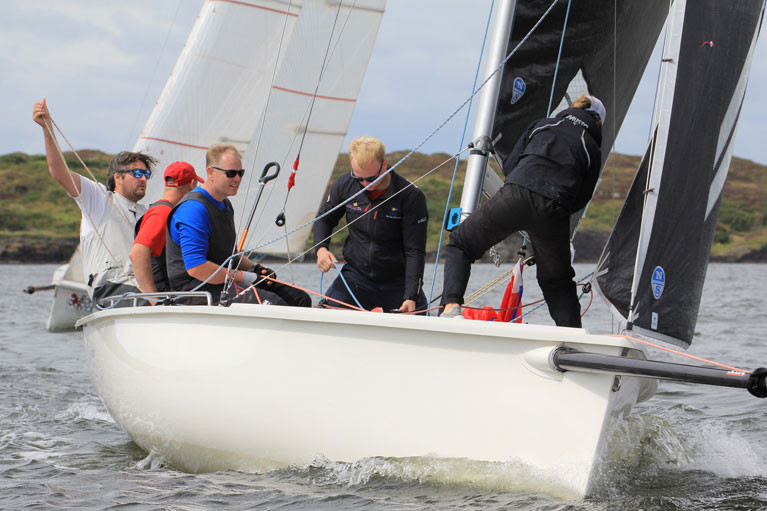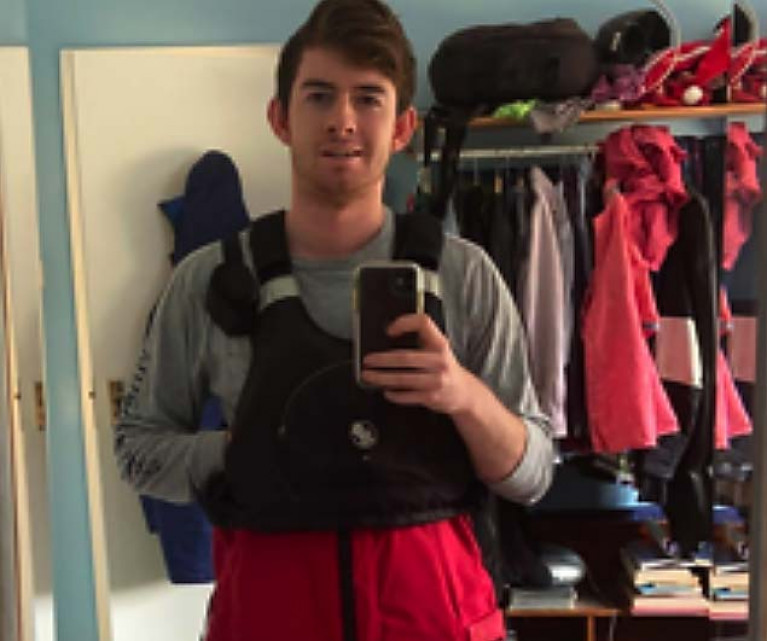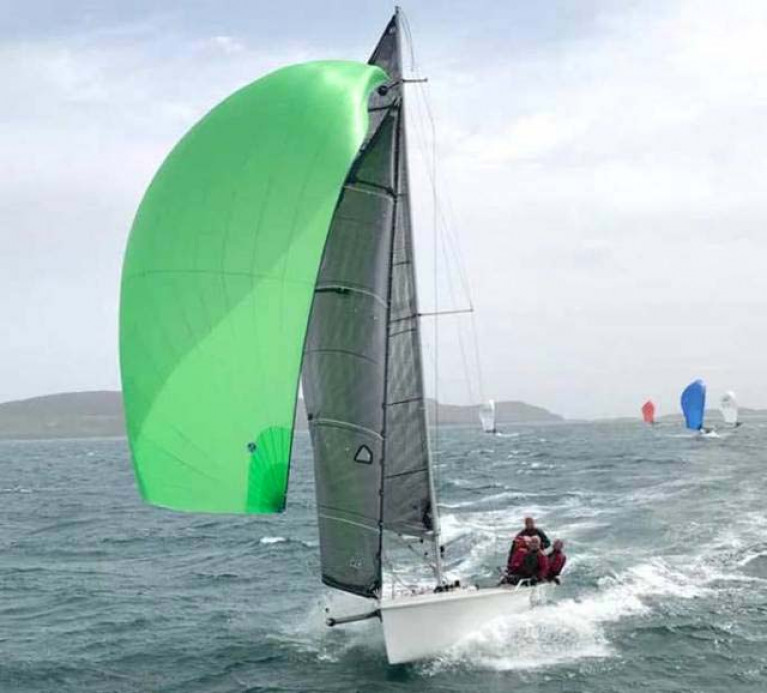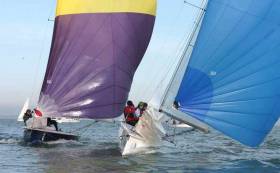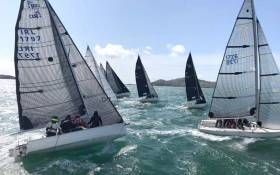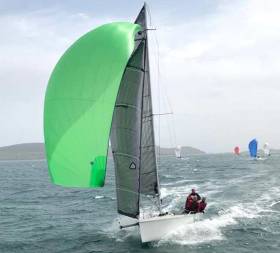Displaying items by tag: 1720
It's very tight at the top of the 14-boat fleet after a breezy first day of the AIB 1720 Southern Championships at Royal Cork Yacht Club yesterday.
Two races were sailed outside Cork Harbour to the South West of Roches Point in 15 - 28 knots of wind under Race Officer Ciaran MacSweeney with Interantional Race Officer Jack Roy also on board the Committee Boat.
Race One was sailed on small sails to ease the fleet into it and Rope Dock Atara had a storming victory.
 Overall leaders - Rob O'Leary and his crew in Dutch Gold from Baltimore Sailing Club lead but are tied on three points with Ropedock Atara Photo: Deirdre Horgan
Overall leaders - Rob O'Leary and his crew in Dutch Gold from Baltimore Sailing Club lead but are tied on three points with Ropedock Atara Photo: Deirdre Horgan
Race Two saw the Q flag lowered, a strengthening tide and an unexpected increase in the breeze. With big sails on it was a monster of a race and with all bar one boat falling over, there was plenty of action.
 Ropedock Atara (Ross McDonald/English) Photo: Deirdre Horgan
Ropedock Atara (Ross McDonald/English) Photo: Deirdre Horgan
This time Robert O'Leary and crew took a convincing first with Atara second and they now share the points lead with a one, two each but with O'Leary winning the final race of the day he sits on top of the scoresheet under the tie-break rule.
 T-Bone (Durcan/O'Shea) from RCYC
T-Bone (Durcan/O'Shea) from RCYC
An early start this morning at 10:25 will see up to four races for the fleet.
 A start at the 1720 AIB sponsored Southern Championships Photo: Deirdre Horgan
A start at the 1720 AIB sponsored Southern Championships Photo: Deirdre Horgan
Results are here
1720 Southern Championships Day One Photo Gallery below
North Sails Ireland 1720 News from the Baltimore Cup
Congratulations to all the North Sails Ireland customers for their great results in the recently held 1720 Baltimore Cup in West Cork.
First overall was Robert O'Leary flying North 3Di Mainsail and Large Jib.
Second overall was Anthony O'Leary flying the same combination of North 3Di sails.
 Second overall was Anthony O'Leary Photo: Deirdre Horgan
Second overall was Anthony O'Leary Photo: Deirdre Horgan
The Durcan Family sailing Team T-Bone was 4th overall Flying 2017 3DL upwind sails and excelling downwind with the latest T-6 spinnaker design.
 1720 T-Bone Photo: Deirdre Horgan
1720 T-Bone Photo: Deirdre Horgan
T-Bone was the only boat to win two races........Great to see this class enjoying such close racing in the beautiful waters of Baltimore.
Back in April 2019, I wrote a piece called "The Trickledown effect" this piece talks about how 3Di started life in the America's Cup and is now on the smallest One Design boats including the 1720. Well worth a read......
Also whilst we are on the subject of 3Di take a look here to understand exactly how it's made. Totally unique in the sailmaking world, when you watch this video it will go some way to explaining why a 3Di sail might cost a little more than a conventional 2D sail.
We look forward to the next 1720 regatta at the end of August as part of the Cork 300 celebrations.
Sail FAST!
Rob O'Leary's 'Dutch Gold' Wins 1720 Baltimore Cup on Countback
The 12-boat 1720 Baltimore Cup was won by Rob O’Leary's Dutch Gold and his crew winning on countback as he was on joint nett points with Finaleg helmed by Anthony O’Leary over a six race series. In third place was Baltimore local boat – Spiced Beef skippered by Fionn Lyden. Full results are here.
Meanwhile, entries are building nicely for the AIB 1720 Southern Championships that will be sailed as part of the Royal Cork Tricentenary At Home Regatta later this month. So far there are nine 1720s entered with a plan to hit 20.
 The 12-boat 1720 sportsboat fleet racing downwind at Baltimore, West Cork Photo: BSC/Facebook
The 12-boat 1720 sportsboat fleet racing downwind at Baltimore, West Cork Photo: BSC/Facebook
How Can Keelboat Racing Work with Social Distancing?
Olympic helmsman, professional sailor and coach Mark Mansfield takes a look at how it may be possible to return to keelboat racing while maintaining social distance onboard.
The latest Government five-phase programme appears to allow the reinstatement of boating and sailing from May the 18th, under certain restrictions.
The RNLI and Coastguard will likewise need to lift their advisory notice as well for this to happen.
Irish Sailing is liaising with the yacht clubs in Ireland and the Government to get clarity on specific aspects of this five-phase plan. In the interim, commencing racing appears to be positioned in Phase 3, which would begin on June the 29th but many sailors are asking; how can this happen under the requirement to also socially distance ourselves from others?
 Article author Mark Mansfield sailed the Star keelboat for Ireland at four Olympic Regattas between 1996 and 2004. He is a multi-class Irish keelboat champion
Article author Mark Mansfield sailed the Star keelboat for Ireland at four Olympic Regattas between 1996 and 2004. He is a multi-class Irish keelboat champion
Other sports are also in the same situation with resumption to training planning on commencing in Phase 2 in early June and some matches in Phase 3. Team sports like soccer, Gaelic, hockey, basketball and others have further complications in that they compete directly against opposition at close quarters.
Luckily in sailing, though we are a team sport, our opposition usually is quite a bit away from us. It is therefore in our own hands how, on boats, we can keep our distance when racing. The following are my thoughts on how this can happen successfully, keeping our sport going in these difficult times.
Dinghies that rely on rescue boats when capsized, and two-person dinghies and smaller keelboats will have additional challenges. However, for the purposes of this article, I will concentrate on larger keelboats that have engines to allow them to look after themselves in the event of an emergency.
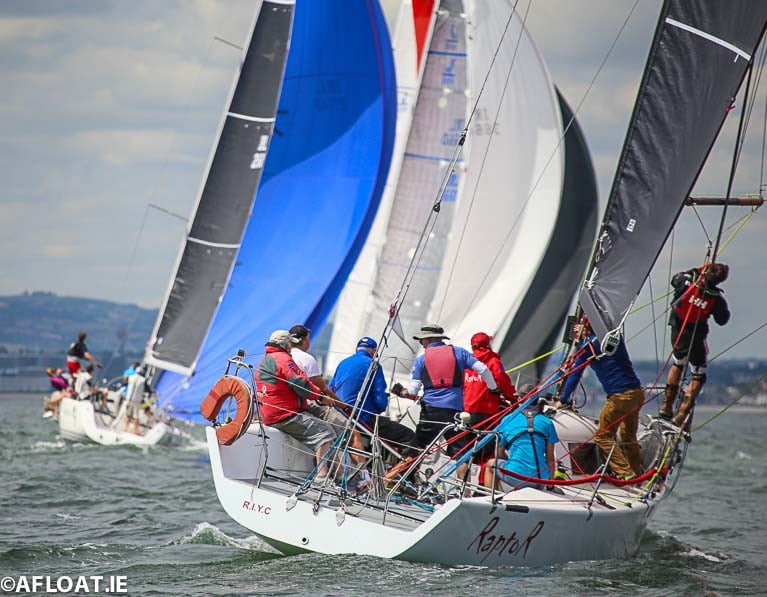 Class One boats approach a leeward mark on Dublin Bay in 2019 Photo: Afloat
Class One boats approach a leeward mark on Dublin Bay in 2019 Photo: Afloat
Fully crewed or shorthanded?
Though there are other options around bubbles, family crew and the like, clearly it will be challenging to sail fully crewed for the first couple of months and still keep the required space between each other. The sight of 8 bodies huddled together on the rail while going upwind on a 35-foot cruiser-racer would not only be regarded as unsafe but irresponsible and would send all the wrong messages.
So, at what crewing levels could racing happen and still keep close to the permitted social distancing levels?
It is possible to specify a max crew level for different sized boats.
Different sized boats have different crewing needs. An SB20 sportsboat, for example, does not need the same crew numbers as a 42-footer. So what crew numbers would be required on different sized boats. Here is my estimate:
- Up to 26 footers 3 max per boat – Only 2 allowed to sit over the side
- Over 26 foot and up to 31 foot – Max of 4 crew – only 2 allowed to sit over the side
- Over 31 foot and up to 36 foot – Max 5 crew – only 2 allowed to sit over the side
- Over 36 foot and up to 41 foot – Max 6 crew – only 3 allowed to sit over the side
- Over 41 foot and up to 46 foot – Max 7 crew and only 4 allowed to sit over the side
And so on in 5-foot sized increases.
An amendment to The Notice of Race (NOR) could be inserted for events to make these reduced numbers a requirement, while we still have these restrictions due to COVID 19.
Is this enough crew to race boats with spinnakers?
In the Fastnet Race in 2019, There were 65 entries in the Two-handed class, ranging from 45 footers, down to 30 footers. Most boats were in the 35-foot size range and used spinnakers. Yes they all would have autopilots, and that effectively gives you an extra pair of hands doing sail changes, but that still would mean that they would have had two less crew than my crew size thoughts above.
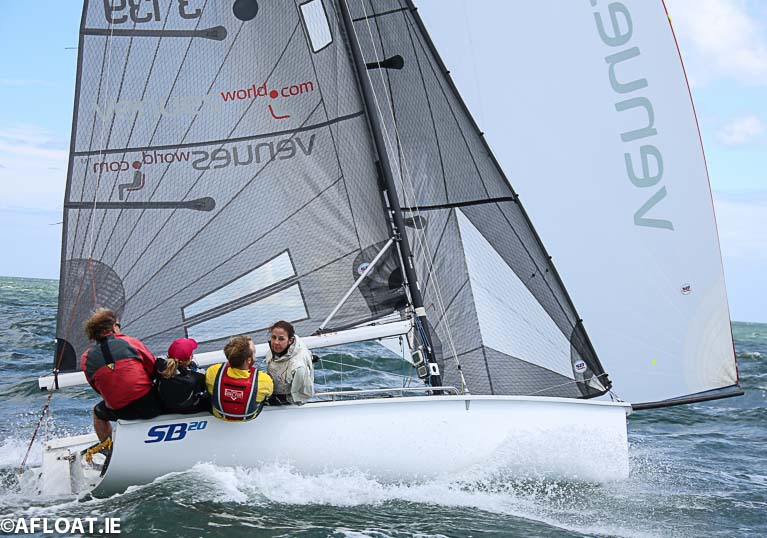 An SB20 racing under spinnaker in strong breeze with a crew of four on Dublin Bay Photo: Afloat
An SB20 racing under spinnaker in strong breeze with a crew of four on Dublin Bay Photo: Afloat
SB20
Certain classes, such as the SB20, would still find it challenging to keep a distance with 3 on board, and having spoken to the class, they could see a possibility, if required, to sail with just 2 crew, particularly in light winds. In stronger winds, they may wish to just sail without spinnakers.
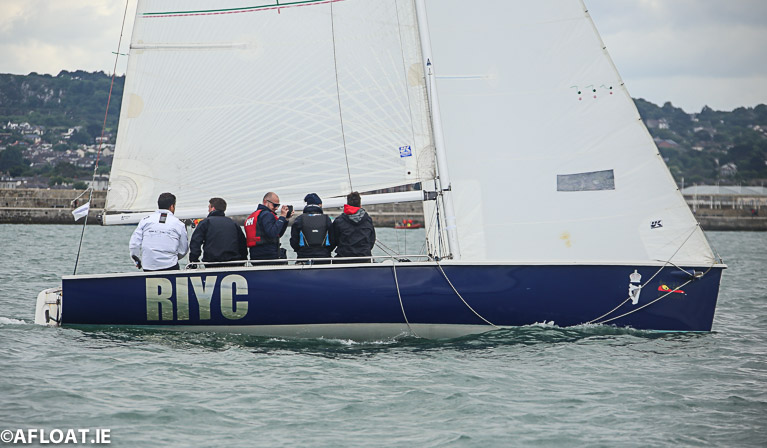 A 1720 keelboat with a crew of five in Dun Laoghaire Harbour Photo: Afloat
A 1720 keelboat with a crew of five in Dun Laoghaire Harbour Photo: Afloat
1720
The 1720 class has also looked at this, and Class Captain Clive O'Shea told Afloat: "If required, the 1720 class is ideally situated to reduce numbers to allow social distancing while racing. Three crew can keep apart, and we still have the option to go with small spinnakers and small jibs, if needed."
So how would this happen on a typical small cruiser, like a J24 or a medium-sized cruiser-racer like a J109?
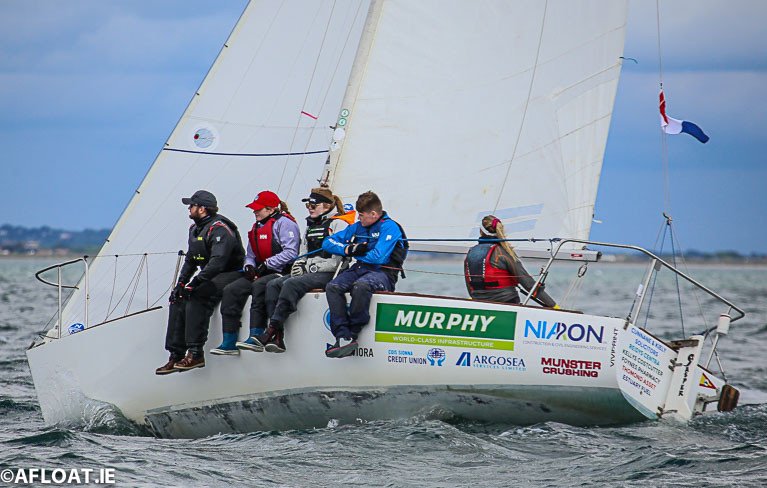 A J24 in racing mode Photo: Afloat
A J24 in racing mode Photo: Afloat
J24
Three crew could handle a J24; One is helming and trimming the main, one in the cockpit, and one on the bow. The Bowman stays forward of the shrouds; the cockpit person stays away from the helm, up by the hatch. It won't be all that easy, but 30-foot boats like Etchells have similar-sized sails and normally sail with 3.
 A fully crewed J109 on Dublin Bay (above) and a two-handed crew on the same model (below)
A fully crewed J109 on Dublin Bay (above) and a two-handed crew on the same model (below)
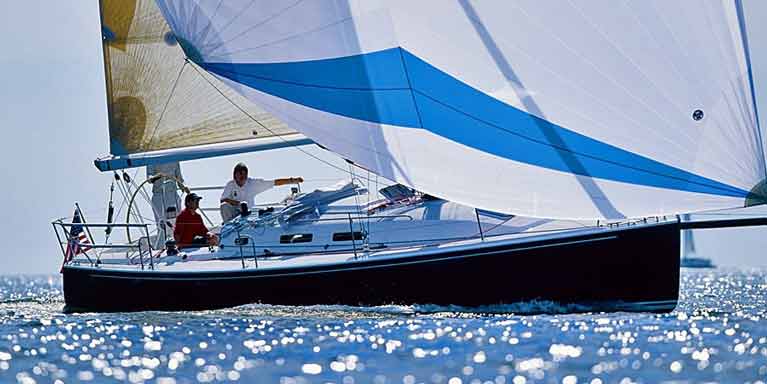
J109
Five on a J109; One on the wheel, staying back a bit. One in the cockpit is trimming the mainsheet but sitting well forward. Helm adjusts the traveller or leaves it in the centre. One sits in the hatch, or on top of the coachroof. The Jib Trimmer sits out, and during tacks, they pull in the new sheet while the Mainsheet Trimmer has let off the old jib sheet. The Bow person sits out forward of the shrouds; jib trimmer sits out to windward, 2 metres back from the Bowman. Downwind more room becomes available as both sides of the boat can accommodate the crew. Andrew Craig, Class Captain of the J109 class in Ireland, says, 'the J109 is well suited to shorthanded racing with the small jib and plenty of space for a reduced number to spread out. The Asymmetrical Spinnaker requires no pole which also makes shorthanded use possible in the right conditions'
White Sails & other options
For those with boats that are harder to sail, or if a crew is not that experienced, there is also the white sails (non-spinnaker) fleet to compete in, until fully crewed racing resumes.
Dublin Bay Sailing Club is the largest yacht racing club in the country with over 250 boats in 20 or so classes. Its Commodore, Johnathon Nicholson has this to add; "Along with the other clubs, DBSC is working with Irish Sailing to create a clear and safe path to get back on the water. We are currently investigating the practicalities of racing short haded with the appropriate physical distancing and when it could be introduced following the guidance provided by the government, Sport Ireland and Irish Sailing".
I appreciate there may be occasions during racing that crew get closer than planned for short periods. This is to be expected, but that will be the situation in virtually all sports that will likely be competing over the next few months. It is incumbent in our sport to come up with a plan to compete as safely as possible. This is just one option, and there will likely be others. Of course, this COVID-19 restriction could be tightened or eased during the next few months, and this proposed plan would then need to be looked at again. Reducing racing crew numbers also decreases the numbers that come back into the clubs allowing easier social distancing ashore.
Ultimately, however, as all sailors know, it is up to each individual skipper and crew to make their own decision about whether to go to sea or not.
Daniel Raymond Leads 1720 Class Virtual Racing League
Extraordinary times call for extraordinary measures. The 1720 class has followed the lead of some other sailing classes and taken the plunge into the world of virtual racing writes Robbie English.
The Rope Dock 1720 VR April League started three weeks ago and has received 40 entrants. Given that each race on the Virtual Regatta platform is limited to 20 entrants, two fleets have been created to accommodate the large number of competitors. Each fleet is randomly selected each week and adds an extra dimension to the racing. The boats used for racing are changed each week also, to keep it interesting and everyone on their toes.
 A large fleet makes for a crowded racecourse and some close racing
A large fleet makes for a crowded racecourse and some close racing
With such a large fleet, the race course has become a congested place! However, this has made for some tight racing as it can be hard to pull away from such a large pack. Results can vary wildly, and has made for an incredibly close leader board. After three weeks of racing, the lead at the top of the board change hands three times. Our current leader is Daniel Raymond, who has found a consistent form that has taken to the top on 63 points. He is followed closely by Darragh McCormack in second on 67 points and Killian Collins in third on 73 points. However, a 10-point lead can we whittled away very quickly!
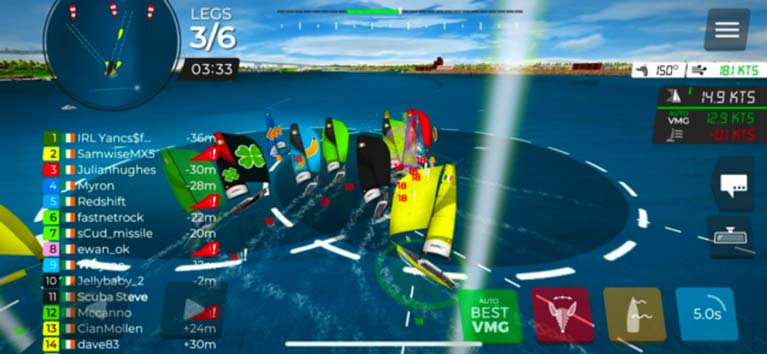 Close racing makes for a jam-packed mark rounding. Here we see a typical leeward gate approach!
Close racing makes for a jam-packed mark rounding. Here we see a typical leeward gate approach!
So, it’s all to play for heading into the final week of racing, which will be on Tuesday night at 20:00. A thank you must go out to our league sponsor, Rope Dock, who have very generously supplied us with the prizes for the league. Who exactly is going to get them, is yet to be determined. Results can be downloaded below.
Baltimore Sailing Club will be hoping for the same conditions that graced last year's West Cork race track when the 1720 sportsboat fleet returns for its National Championships from 25 – 27 September 2020.
As Afloat reported last September, a buoyant 20-boat fleet contested the championship in 2019 won by the host club's Robert O'Leary with six top-five results from eight sailed including three race wins.
A Notice of Race – will be published in due course.
Corporate Yacht Racing League for Dublin Bay in 2020
The Irish National Sailing & Powerboat School has launched a corporate racing league on Dublin Bay in 2020.
Racing will take place on Wednesday evenings in 1720s.
How many times have sailors’ colleagues asked, “when are you taking us out sailing?”. This league provides the solution.
A mixed ability crew, lead by a competent skipper, will take charge of a 1720. This benefits for the company involved extend beyond team building and include putting the brand front and centre of a new participation initiative for sailing in Ireland.
Ten identical 1720s are available for crews of 5 from the same company. They’ll be competing against other companies in a series over 5 Wednesday evenings. A training and familiarisation evening will be held on the 29th of April, followed by 4 evenings of competition, running 6th, 13th, 20th, and 27th May.
The après sail will take the form of a meal or BBQ at the Royal Irish Yacht Club. The school is targeting 50 participants. Teams of experienced hands, as well as mixed ability crews, are welcome.
The concept has developed from a visit to Dún Laoghaire by Quarterdeck, the skipper training agency for The Yacht Week last September, where 60 international skippers competed aboard 1720s on the Bay. Combining the on the water action with the shoreside services of Dún Laoghaire’s waterfront will hopefully prove a winning combination. The school produced a short video of the Quarterdeck event, showing what could be on offer for companies this Summer.
A prospectus for interested parties has been prepared here (downloadable below)
Rob O'Leary's 1720 'Spiced Beef' Claims Sportsboat Title in Baltimore
A breezy 1720 sportsboat National Championships at Baltimore Sailing Club saw Rob O'Leary's 'Spiced Beef' at the top of the leaderboard over three days in West Cork.
In a consistent showing, O'Leary and his crew dominated the 20-boat fleet and with six top five results from eight sailed and three race wins.
Second overall and six points off the title was O'Leary's father Anthony sailing Antix from Royal Cork YC. Ben Cooke's Smile 'n' Wave from the Royal St. George Yacht Club finished third but on the same nett points as Antix.
Results are below
| Spiced Beef | 1848 | Rob O'Leary | Baltimore SC | 1.0 | 5.0 | 2.0 | (7.0) | 1.0 | 1.0 | 5.0 | 5.0 | 27.0 | 20.0 | |
| 2nd | Antix | 2020 | Anthony O'Leary | Baltimore SC/Royal Cork YC | 3.0 | 7.0 | 6.0 | 1.0 | 2.0 | 3.0 | 4.0 | (11.0) | 37.0 | 26.0 |
| 3rd | Smile 'n' Wave | 1722 | Ben Cooke | Baltimore SC/Royal St George YC | 2.0 | 2.0 | 8.0 | 3.0 | 4.0 | 5.0 | 2.0 | (10.0) | 36.0 | 26.0 |
| 4th | Live Wire | 1755 | Fionn Lyden | Baltimore SC | 5.0 | 8.0 | (21.0 DSQ) | 8.0 | 5.0 | 6.0 | 13.0 | 4.0 | 70.0 | 49.0 |
| 5th | T-Bone | 1790 | Johnny Durcan | Royal Cork YC/Baltimore SC | 6.0 | (21.0 DNS) | 21.0 DNS | 5.0 | 3.0 | 2.0 | 7.0 | 6.0 | 71.0 | 50.0 |
| 6th | Dark Side | 797 | Brian Twomey | Royal Cork YC | 7.0 | 9.0 | (21.0 DSQ) | 9.0 | 7.0 | 8.0 | 9.0 | 2.0 | 72.0 | 51.0 |
| 7th | Two to Tango | 1785 | Peter O'Flynn | Baltimore SC | 15.0 | 13.0 | (21.0 RET) | 4.0 | 6.0 | 10.0 | 1.0 | 9.0 | 79.0 | 58.0 |
| 8th | efolioaccounts.com | 1724 | Neil Hegarty | Baltimore SC | 11.0 | 3.0 | 11.0 | 11.0 | (14.0) | 4.0 | 11.0 | 7.0 | 72.0 | 58.0 |
| 9th | Elder Lemon | 2888 | Robert Dix | Baltimore SC | (10.0) | 10.0 | 5.0 | 10.0 | 10.0 | 9.0 | 6.0 | 8.0 | 68.0 | 58.0 |
| 10th | Wet and Black | 1843 | Dan O'Grady | Howth Yacht Club | 8.0 | (21.0 BFD) | 4.0 | 6.0 | 13.0 | 21.0 RET | 8.0 | 1.0 | 82.0 | 61.0 |
| 11th | After Midnight | 1797 | Conor Baynes | Galway Bay SC | (16.0) | 12.0 | 10.0 | 13.0 | 9.0 | 7.0 | 12.0 | 12.0 | 91.0 | 75.0 |
| 12th | Da Fishy | 1726 | Donagh Good | Royal Cork YC | (21.0 RET) | 4.0 | 1.0 | 2.0 | 8.0 | 21.0 RET | 21.0 DNS | 21.0 DNS | 99.0 | 78.0 |
| 13th | Cosmic | 1760L | Pat Tanner | Baltimore SC | 13.0 | 6.0 | 9.0 | (21.0 BFD) | 12.0 | 11.0 | 16.0 | 13.0 | 101.0 | 80.0 |
| 14th | RCYC2 | 180 | Luke McGrath | Royal Cork YC | (17.0) | 14.0 | 7.0 | 14.0 | 11.0 | 12.0 | 15.0 | 14.0 | 104.0 | 87.0 |
| 15th | Deja Vu | 1777 | Ross Johnson | Baltimore SC | 12.0 | (21.0 BFD) | 3.0 | 12.0 | 21.0 RET | 21.0 RET | 10.0 | 15.0 | 115.0 | 94.0 |
| 16th | Ropedock Atara | 2000 | Ross McDonald | Howth Yacht Club | 9.0 | (21.0 RET) | 21.0 DNS | 21.0 DNS | 21.0 DNS | 21.0 DNS | 3.0 | 3.0 | 120.0 | 99.0 |
| 17th | INSS | 1775 | Kenny Rumball | INSS | 4.0 | 1.0 | (21.0 RET) | 21.0 DNS | 21.0 DNS | 21.0 DNS | 21.0 DNS | 21.0 DNS | 131.0 | 110.0 |
| 18th | Aquatack | 1804 | Mia Murphy | Royal Cork YC | 18.0 | (21.0 BFD) | 21.0 RET | 15.0 | 15.0 | 13.0 | 14.0 | 16.0 | 133.0 | 112.0 |
| 19th | 1601 | 1773 | Bobby Nash | Kinsale Yacht Club | 14.0 | 11.0 | (21.0 RET) | 21.0 DNS | 21.0 DNS | 21.0 DNS | 21.0 DNS | 21.0 DNS | 151.0 | 130.0 |
| 20th | Mini-Apple | 1780 | David Love | Royal Cork YC | (21.0 RET) | 21.0 RET | 21.0 DNS | 21.0 DNS | 21.0 DNS | 21.0 DNS | 21.0 DNS | 21.0 DNS | 168.0 |
147.0
|
O'Leary's Battle for 1720 Sportsboat Championship Lead at Baltimore
With three race wins to his credit, the host club's Rob O'Leary has built a five-point margin over his father after six races sailed at the 1720 National Championships in Baltimore, West Cork.
Third in the 20 boat fleet is Royal St George YC's Ben Cooke on Smile 'n' Wave.
Racing continues on Sunday.
Results after six races sailed below
| 1st | Spiced Beef | 1848 | Rob O'Leary | Baltimore SC | 1.0 | 5.0 | 2.0 | (7.0) | 1.0 | 1.0 | 17.0 | 10.0 |
| 2nd | Antix | 2020 | Anthony O'Leary | Baltimore SC/Royal Cork YC | 3.0 | (7.0) | 6.0 | 1.0 | 2.0 | 3.0 | 22.0 | 15.0 |
| 3rd | Smile 'n' Wave | 1722 | Ben Cooke | Baltimore SC/Royal St George YC | 2.0 | 2.0 | (8.0) | 3.0 | 4.0 | 5.0 | 24.0 | 16.0 |
| 4th | Live Wire | 1755 | Fionn Lyden | Baltimore SC | 5.0 | 8.0 | (21.0 DSQ) | 8.0 | 5.0 | 6.0 | 53.0 | 32.0 |
| 5th | Da Fishy | 1726 | Donagh Good | Royal Cork YC | (21.0 RET) | 4.0 | 1.0 | 2.0 | 8.0 | 21.0 RET | 57.0 | 36.0 |
| 6th | T-Bone | 1790 | Johnny Durcan | Royal Cork YC/Baltimore SC | 6.0 | (21.0 DNS) | 21.0 DNS | 5.0 | 3.0 | 2.0 | 58.0 | 37.0 |
| 7th | efolioaccounts.com | 1724 | Neil Hegarty | Baltimore SC | 11.0 | 3.0 | 11.0 | 11.0 | (14.0) | 4.0 | 54.0 | 40.0 |
| 8th | Dark Side | 797 | Brian Twomey | Royal Cork YC | 7.0 | 9.0 | (21.0 DSQ) | 9.0 | 7.0 | 8.0 | 61.0 | 40.0 |
| 9th | Elder Lemon | 2888 | Robert Dix | Baltimore SC | (10.0) | 10.0 | 5.0 | 10.0 | 10.0 | 9.0 | 54.0 | 44.0 |
| 10th | Two to Tango | 1785 | Peter O'Flynn | Baltimore SC | 15.0 | 13.0 | (21.0 RET) | 4.0 | 6.0 | 10.0 | 69.0 | 48.0 |
| 11th | Cosmic | 1760L | Pat Tanner | Baltimore SC | 13.0 | 6.0 | 9.0 | (21.0 BFD) | 12.0 | 11.0 | 72.0 | 51.0 |
| 12th | After Midnight | 1797 | Conor Baynes | Galway Bay SC | (16.0) | 12.0 | 10.0 | 13.0 | 9.0 | 7.0 | 67.0 | 51.0 |
| 13th | Wet and Black | 1843 | Dan O'Grady | Howth Yacht Club | 8.0 | (21.0 BFD) | 4.0 | 6.0 | 13.0 | 21.0 RET | 73.0 | 52.0 |
| 14th | RCYC2 | 180 | Luke McGrath | Royal Cork YC | (17.0) | 14.0 | 7.0 | 14.0 | 11.0 | 12.0 | 75.0 | 58.0 |
| 15th | INSS | 1775 | Kenny Rumball | INSS | 4.0 | 1.0 | (21.0 RET) | 21.0 DNS | 21.0 DNS | 21.0 DNS | 89.0 | 68.0 |
| 16th | Deja Vu | 1777 | Ross Johnson | Baltimore SC | 12.0 | (21.0 BFD) | 3.0 | 12.0 | 21.0 RET | 21.0 RET | 90.0 | 69.0 |
| 17th | Aquatack | 1804 | Julie Neville | Royal Cork YC | 18.0 | (21.0 BFD) | 21.0 RET | 15.0 | 15.0 | 13.0 | 103.0 | 82.0 |
| 18th | 1601 | 1773 | Bobby Nash | Kinsale Yacht Club | 14.0 | 11.0 | (21.0 RET) | 21.0 DNS | 21.0 DNS | 21.0 DNS | 109.0 | 88.0 |
| 19th | Ropedock Atara | 2000 | Ross McDonald | Howth Yacht Club | 9.0 | (21.0 RET) | 21.0 DNS | 21.0 DNS | 21.0 DNS | 21.0 DNS | 114.0 | 93.0 |
| 20th | Mini-Apple | 1780 | David Love | Royal Cork YC | (21.0 RET) | 21.0 RET | 21.0 DNS | 21.0 DNS | 21.0 DNS | 21.0 DNS | 126.0 |
105.
|
Rob O'Leary Takes the Lead at 1720 Nationals at Baltimore
A breezy start to the 1720 sportsboat National Championships sees Rob O'Leary's 'Spiced Beef' jump into the lead after three incident-packed races on day one in Baltimore, West Cork.
After two generals racing started under the black flag on the third attempt for the 20-boat fleet.
Second overall and four points off the lead is Ben Cooke's Smile 'n' Wave from the Royal St. George Yacht Club. Third is Anthony O'Leary in Antix from Royal Cork YC.
After a promising start (4,1) the championships came to an abrupt end for Dun Laoghaire's Kenny Rumball who was T-boned in the third race with some serious damage as pictured below.
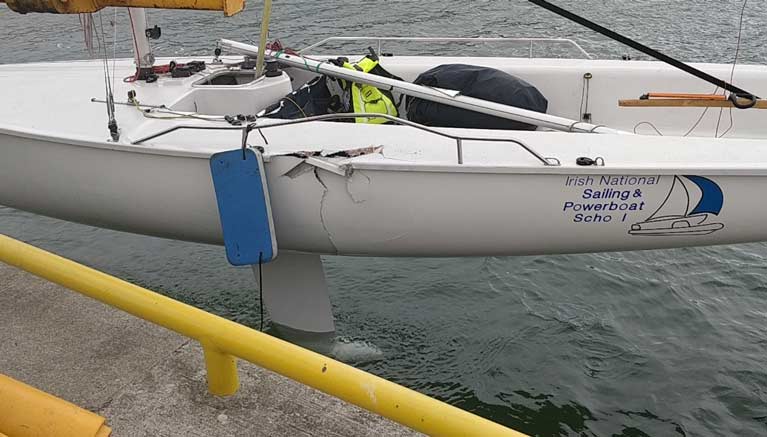 The INSS 1720 is hauled out with port side damage sustained in race three
The INSS 1720 is hauled out with port side damage sustained in race three
Racing continues in Baltimore 'til Sunday.
Results after three races are below
| Rank | Boat Name | SailNo | HelmName | Club | R1 | R2 | R3 | Total | Nett |
|---|---|---|---|---|---|---|---|---|---|
| 1st | Spiced Beef | 1848 | Rob O'Leary | Baltimore SC | 1.0 | 5.0 | 2.0 | 8.0 | 8.0 |
| 2nd | Smile 'n' Wave | 1722 | Ben Cooke | Baltimore SC/Royal St George YC | 2.0 | 2.0 | 8.0 | 12.0 | 12.0 |
| 3rd | Antix | 2020 | Anthony O'Leary | Baltimore SC/Royal Cork YC | 3.0 | 7.0 | 6.0 | 16.0 | 16.0 |
| 4th | Elder Lemon | 2888 | Robert Dix | Baltimore SC | 10.0 | 10.0 | 5.0 | 25.0 | 25.0 |
| 5th | Da Fishy | 1726 | Donagh Good | Royal Cork YC | 21.0 RET | 4.0 | 1.0 | 26.0 | 26.0 |
| 6th | INSS | 1775 | Kenny Rumball | INSS | 4.0 | 1.0 | 21.0 RET | 26.0 | 26.0 |
| 7th | efolioaccounts.com | 1724 | Neil Hegarty | Baltimore SC | 11.0 | 3.0 | 12.0 | 26.0 | 26.0 |
| 8th | Dark Side | 797 | Brian Twomey | Royal Cork YC | 7.0 | 9.0 | 11.0 | 27.0 | 27.0 |
| 9th | Cosmic | 1760L | Pat Tanner | Baltimore SC | 13.0 | 6.0 | 9.0 | 28.0 | 28.0 |
| 10th | Wet and Black | 1843 | Dan O'Grady | Howth Yacht Club | 8.0 | 21.0 BFD | 4.0 | 33.0 | 33.0 |
| 11th | Live Wire | 1755 | Fionn Lyden | Baltimore SC | 5.0 | 8.0 | 21.0 RET | 34.0 | 34.0 |
| 12th | Deja Vu | 1777 | Ross Johnson | Baltimore SC | 12.0 | 21.0 BFD | 3.0 | 36.0 | 36.0 |
| 13th | RCYC2 | 180 | Luke McGrath | Royal Cork YC | 17.0 | 14.0 | 7.0 | 38.0 | 38.0 |
| 14th | After Midnight | 1797 | Conor Baynes | Galway Bay SC | 16.0 | 12.0 | 10.0 | 38.0 | 38.0 |
| 15th | 1601 | 1773 | Bobby Nash | Kinsale Yacht Club | 14.0 | 11.0 | 21.0 RET | 46.0 | 46.0 |
| 16th | T-Bone | 1790 | Johnny Durcan | Royal Cork YC/Baltimore SC | 6.0 | 21.0 DNS | 21.0 DNS | 48.0 | 48.0 |
| 17th | Two to Tango | 1785 | Peter O'Flynn | Baltimore SC | 15.0 | 13.0 | 21.0 RET | 49.0 | 49.0 |
| 18th | Ropedock Atara | 2000 | Ross McDonald | Howth Yacht Club | 9.0 | 21.0 RET | 21.0 DNS | 51.0 | 51.0 |
| 19th | Aquatack | 1804 | Julie Neville | Royal Cork YC | 18.0 | 21.0 BFD | 21.0 RET | 60.0 | 60.0 |
| 20th | Mini-Apple | 1780 | David Love | Royal Cork YC | 21.0 RET | 21.0 RET | 21.0 DNS | 63.0 | 63.0 |



























